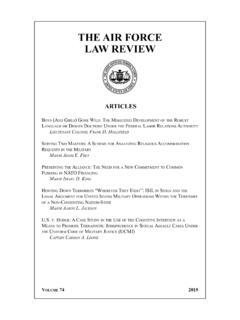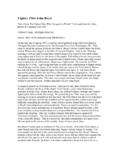Transcription of Reducing Air Force Fighter Pilot Shortages
1 Albert A. Robbert, Anthony D. Rosello, Clarence R. Anderegg, John A. Ausink, James H. Bigelow, William W. Taylor, James PitaReducing Air Force Fighter Pilot ShortagesCORPORATIONL imited Print and Electronic Distribution RightsThis document and trademark(s) contained herein are protected by law. This representation of RAND intellectual property is provided for noncommercial use only. Unauthorized posting of this publication online is prohibited. Permission is given to duplicate this document for personal use only, as long as it is unaltered and complete. Permission is required from RAND to reproduce, or reuse in another form, any of its research documents for commercial use. For information on reprint and linking permissions, please visit RAND Corporation is a research organization that develops solutions to public policy challenges to help make communities throughout the world safer and more secure, healthier and more prosperous.
2 RAND is nonprofit, nonpartisan, and committed to the public interest. RAND s publications do not necessarily reflect the opinions of its research clients and RANDMake a tax-deductible charitable contribution at of Congress Cataloging-in-Publication Data is available for this : 978-0-8330-9173-4 For more information on this publication, visit by the RAND Corporation, Santa Monica, Calif. Copyright 2015 RAND CorporationR is a registered trademark. iii Preface The Air Force has faced a persistent challenge in that active-component Fighter Pilot requirements (particularly nonflying staff requirements) exceed its capacity to train and provide initial operational experience to a sufficient number of officers to fill these requirements. The objective of this report is to examine alternatives available to help close the resulting gaps. Since some solutions would rely on reserve-component resources, we also examined prevailing Shortages of Fighter pilots in the reserve components.
3 This research was sponsored by four elements of the Air Force : the Deputy Chief of Staff for Operations (AF/A3); the Deputy Chief of Staff for Manpower, Personnel and Services (AF/A1); the Commander, Air Force Reserve Command (AFRC/CC); and the Director, Air National Guard (NGB/CF). The research described in this report was conducted within the Manpower, Personnel, and Training Program of RAND Project AIR Force as part of a fiscal year 2014 study Rated Requirements Assessment. RAND Project AIR Force RAND Project AIR Force (PAF), a division of the RAND Corporation, is the Air Force s federally funded research and development center for studies and analyses. PAF provides the Air Force with independent analyses of policy alternatives affecting the development, employment, combat readiness, and support of current and future air, space, and cyber forces. Research is conducted in four programs: Force Modernization and Employment; Manpower, Personnel, and Training; Resource Management; and Strategy and Doctrine.
4 Additional information about PAF is available on our website: This report documents work originally shared with the Air Force on October 16, 2014. The draft report, issued on October 31, 2014, was reviewed by formal peer reviewers and Air Force subject-matter experts. v Contents Preface .. iii Figures and Tables .. vii Summary .. ix Acknowledgments .. xiii Abbreviations .. xv 1. Introduction .. 1 Addressing Fighter Pilot Shortages .. 3 Organization of the Report .. 4 2. Aircrew Management Dynamics .. 7 Fundamental Elements .. 7 Training Production .. 8 Absorption .. 8 Sustainment .. 9 Buffers .. 10 Modeling Absorption Capacity .. 10 Addressing the Imbalances .. 11 Increasing Supply .. 12 Reducing Demand .. 12 3. Increasing Supply .. 15 Training Production .. 15 Absorption .. 16 Increasing Absorbing Positions .. 16 Increasing Absorption Capacity in Existing Force Structure.
5 16 Retention .. 18 Using RC Resources to Meet AC Requirements .. 19 4. Reducing Demand .. 21 Past Reductions .. 21 Further Reductions .. 22 Converting Fighter Pilot Requirements to Other Workforce Types .. 22 Transferring Requirements from the AC to the RC .. 23 Converting Nonabsorbing Positions to Absorbing .. 23 Eliminating Requirements .. 24 5. Paths Toward Balance .. 25 A Steady-State Approach .. 25 Identifying a Long-Range Requirement .. 26 Increasing Supply .. 26 vi Increased Flying Hours and Simulator Usage .. 26 Additional Active Associate Units .. 27 Increased First-Assignment Instructor pilots .. 27 Increased Retention .. 28 Using Reservists to Meet AC Requirements .. 28 Net Effect of Potential Supply-Side Alternatives .. 28 Reducing Demand .. 29 Increasing Demand with a Leveraged Increase in Supply .. 29 Continued Attention to Aircrew Management Dynamics.
6 31 Appendix A: Fighter Squadron Absorption Capacity .. 33 Appendix B: RAND s Total Force Blue Line Model .. 39 Appendix C: Pilot Shortages in RC Fighter Units .. 43 Appendix D: Impacts of Fighter Force Structure Reductions on Fighter Pilot Inventory Management .. 47 Appendix E: Post Cold War Aircrew Management Decisions .. 55 Appendix F: Previous Reductions in Nonabsorbing Fighter Pilot Positions .. 59 References .. 63 vii Figures and Tables Figures Figure Projected Shortfall in AC Fighter pilots .. ix Figure Projected Shortfall in AC Fighter pilots .. 2 Figure FY 2014 Rated Staff Allocation Plan (RSAP) Summary .. 3 Figure Fundamental Elements of Pilot Management .. 7 Figure Elements of a Steady-State Fighter Absorption Model .. 11 Figure Historic TARS Values for AC Fighter pilots .. 19 Figure Historical Attrition Rates of AC Fighter and Other pilots (FYs 2004 2013).
7 41 Figure Historical Attrition Rates of RC Fighter and Mobility pilots (FYs 2004 2013).. 41 Figure Historical Pilot Affiliation Rates (FYs 2004 2013) .. 42 Figure Total Force Fighter Inventory (FYs 1990 2013) .. 47 Figure Fighter Pilot Production Goals, Inventories, and Requirements .. 51 Figure AC Fighter Pilot Absorption Capacity and Production .. 53 Figure RSAP Prioritizations for Requirements Outside of Line Flying Units (FYs 2004 2014) .. 59 Figure Change in Fighter Pilot Authorization in Air Liaison Officer, Staff, Joint, and Test Flying Organizations (FYs 2009 2014) .. 60 Figure Air Force Staff Fighter Pilot Authorizations, FYs 2004 2014 .. 61 Tables Table Base Case and an Alternative Path Toward Balance .. xi Table Calculating Unit Absorption Capacity .. 33 Table Calculating Total Sustainable Inventories .. 35 Table Impact of Aircrew Management Options on Absorption Capacity and Sustainable Inventories.
8 37 Table Selected ANG Fighter Unit Manning Levels, SUPT Inputs, and ACA Mission .. 45 Table Total Force Fighter PMAI (FYs 2000 2013) .. 48 Table Descriptive Terms for Operational Units .. 49 Table AC Fighter Pilot Production Goals and Actual Production .. 50 ix Summary Although overall Air Force Pilot manning is adequate, the Air Force faces a persistent shortage of Fighter pilots . The expected magnitude of the shortfall in the active component (AC) is shown in Figure Similar Shortages exist in the reserve components (RCs) the Air National Guard (ANG) and Air Force Reserve Command (AFRC) but with a difference. The AC prioritizes its manning such that Shortages are primarily in headquarters staffs and other billets outside of operational squadrons, while RC Shortages are primarily in ANG operational squadrons. The objective of this report is to examine alternatives available to help close the resulting Shortages .
9 Figure Projected Shortfall in AC Fighter pilots SOURCE: Headquarters United States Air Force (AF/A30-A), Alt FY15 POM Fighter Impacts and Recommendations, 2013. Based on the alternate FY 2015 Program Objective Memorandum, including A-10, F-15C, and F-35 changes, large F-16 active associations, and some offset of AC requirements using Military Personnel Appropriation (MPA) man-days. In the AC, the key elements that determine the size of the Pilot inventory are the capacity to train new pilots (production), the capacity to introduce new pilots into operational units and give them enough flying time to turn them into experienced pilots (absorption), and the retention of experienced pilots that largely determines how many new pilots are required each year (sustainment). In the RCs, production and absorption are less critical because most of their sustainment needs are met by separating AC pilots who affiliate with RC units.
10 X Production, absorption, and sustainment make up a dynamic system that is in balance only if long-run production and absorption capacities are greater than sustainment needs and if production does not exceed absorption capacity. During the past several decades, the Air Force has faced reductions in its Fighter aircraft inventory that have caused its absorption capacity to fall below its sustainment needs, yielding persistent shortfalls, such as those depicted in Figure At times, production of new pilots was programmed at levels that would sustain required inventories but exceeded available absorption capacity. The result was broken units (due to too many inexperienced pilots in the units). To eliminate its projected shortfalls, the Air Force may either increase the supply of pilots or reduce certain types of demands. Supply can be increased by increasing the number of operational aircraft that can be used to absorb new pilots (which also increases demand, but by a lesser amount than the associated increase in sustainable supply) or by increasing the absorption capacity of existing operational aircraft inventory.



















